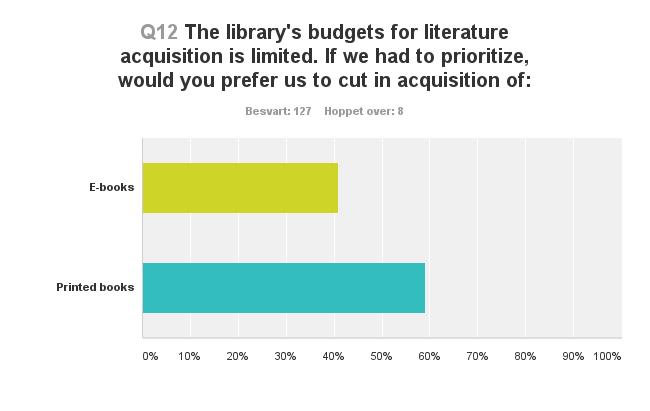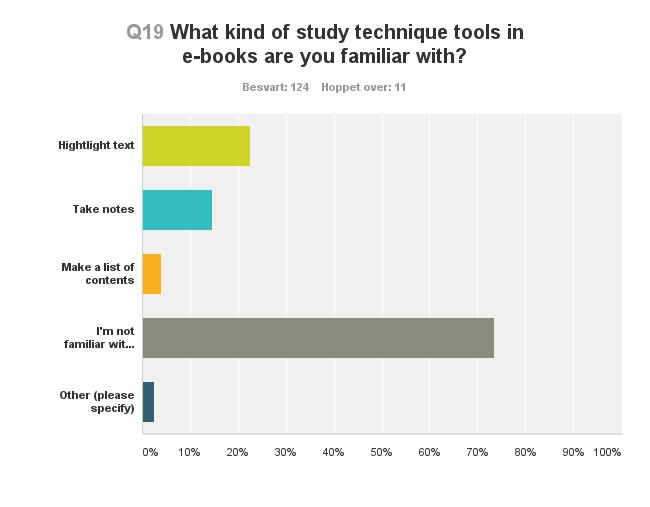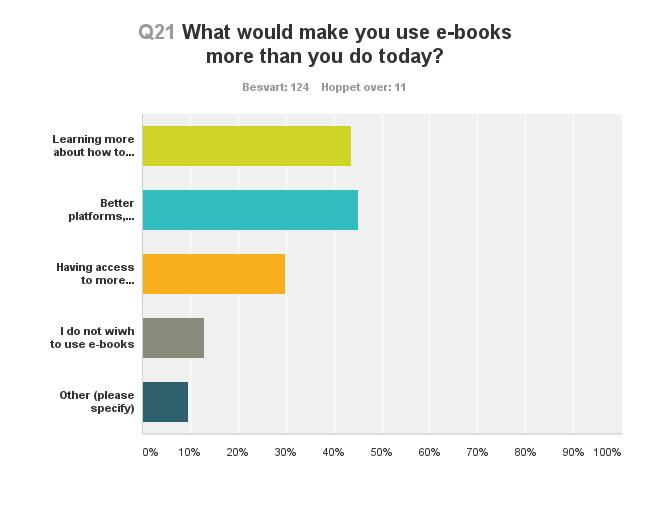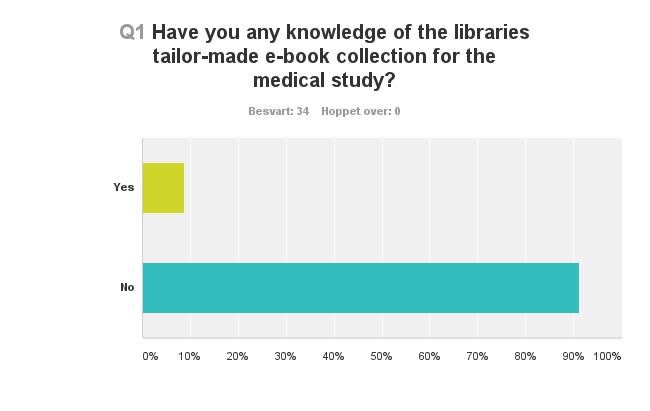Katrine Aronsen (1), Anja Johansen (2), Jan Ove Rein (3)
- Medicine and Health Library, Norwegian University of Science and Technology, Trondheim, Norway
- Medicine and Health Library, Norwegian University of Science and Technology, Trondheim, Norway
- Medicine and Health Library, Norwegian University of Science and Technology, Trondheim, Norway
Corresponding author: Katrine Aronsen, katrine.aronsen@ub.ntnu.no
Abstract
Digital textbooks made available from the library should be an important resource for students, assuming they have digital competence and are interested in saving money. However, usage statistics and research on students preferences regarding printed versus electronic books does not necessarily give the same impression. As digital textbooks are expensive to purchase, this presents a challenge for university libraries today who need to document high usage in order to justify investments.
Representatives from the Medicine and Health Library at NTNU have previously presented at two EAHIL conferences on the subject of providing e-books from the curriculum. We presented three strategies for making digital textbooks more accessible to our users, hoping this would increase the usage. First, we provided e-book titles that were in high demand. Second, we made accessing the e-books easy through a tailored web page. Third, every student has been thoroughly informed about the service through introduction lectures. However, despite our efforts to optimize high usage of the e-books in the last years, the statistics are not as favorable as we expected.
In order to justify the e-book service tailored for the students we need to investigate the reasons for low usage. We want to do this through asking the users, and to investigate the attitudes and preferences of both students and lecturers at the Faculty of Medicine, NTNU.
A recent international study on student’s preferences in regard to print versus electronic course material showed a strong preference for reading in print. Comments suggest that students want both printed and electronic material and show some lack of skills for working with electronic documents. Many students also feel that they have a better learning outcome when reading in print. This study had participants from our university (NTNU), but not from the Faculty of Medicine. Therefore, we want to conduct a user-survey on e-books among the medical students and lecturers. In our survey we want to compare the medical students answers to the international survey, and also in addition ask some more specific questions about our tailored e-book offer.
Our aim for this survey is the following: 1) To explore the attitudes towards e-books in general, 2) to map their knowledge of and experience with the digital textbook services from the library, and, on the basis of this, 3) find out what the library can do to facilitate and increase the use of e-books among students.
Keywords (MeSH): Surveys and Questionnaires; Students, Medical; Libraries, Medical; Books; Libraries, Digital; Attitude
Background
During the last decade university libraries world-wide have focused on providing electronic resources and textbooks to their users, as part of a general turn towards e-resources in education and publishing. In many libraries printed journals have been more or less replaced by e-journals, and successfully so. Assuming that students value online access the turn to e-books seems like a sensible strategy for libraries. However, user statistics and research on students reading format preferences do not necessarily give the same impression. As digital textbooks are expensive to purchase, this presents a challenge for university libraries who need to justify further investments. Is the low usage due to a lack of knowledge about e-books among students and lecturers? Or do students simply prefer reading texts in print format?
At the Medicine and Health Library, NTNU, we have explored different strategies for making e-books more visible and accessible for students and staff. These strategies have been presented at earlier EAHIL conferences. First, we provided e-book titles that were in high demand. Second, we made accessing the e-books more easy through a tailored web page. Third, every student has been thoroughly informed about the service through introduction lectures. However, despite our efforts to optimize high usage of the e-books in the last years, the statistics are not as favorable as we expected. In order to justify the e-book service tailored for the students we need to know more about the reasons for low usage, and discuss how these findings should influence library collection policies.
Aim and research questions
Recent research on student’s reading format preferences report a strong preference for reading in print, even though students consider various advantages of electronic formats (1, 2, 3). Some of these studies also discuss learning outcomes when reading in print versus electronic form, and conclude that reading in print provides better comprehension and learning outcome (4). However, others have problematized such findings, stating that learning outcome and comprehension is closely related to habits and familiarity with formats and that it is possible to overcome “screen inferiority” in learning and calibration (5).
These studies have mainly focused on students reading format preferences in general, and few have participants from Norwegian universities. One of the articles recently published is based on data from a multinational study and had participants from our university (NTNU), although not from the Faculty of Medicine (1). Comments in this survey suggest that students want both printed and electronic material, but they also reveal that students lack skills for working with electronic documents (1). Therefore, we want to conduct a survey among students and staff at the Faculty of Medicine, to find out more about our users attitudes and familiarity with e-books and their functionality.
In our study we compare results to findings in the previous multinational survey, and ask some more specific questions about our tailored e-book offer. As such, the study does not only focus on reading format preferences but also about the provision of e-resources in a library setting. Assuming that the lecturers have an impact on their students awareness of resources from the library, asking them can be seen as a supplement to the students survey – cross-checking findings on how students come to learn about the library’s e-resources/books.
Our aim for this survey is the following: 1) To explore the attitudes towards e-books in general, 2) to map their knowledge of and experience with the digital textbook services from the library, and, on the basis of this, 3) find out what the library can do to facilitate and increase the use of e-books among students.
Methods
Data and comments for this paper is gathered using online questionnaires, generated by Survey Monkey. The study was conducted in April 2016, and survey students and lectures at the Faculty of Medicine, NTNU. We developed two questionnaires, one for students and one for lecturers.
For ease of comparison, the survey targeting students is largely based on the structure and content of the questionnaires used in the before mentioned study (1). However, some questions have been adjusted, and others about our services are added. This survey comprises three parts. The first part consists of a set of 11 statements about students reading formats, followed by a scenario for library collection development with two alternatives. The second part consisted of 10 questions about study habits, their familiarity with e-books in general and services provided by the library. The third part gathered demographic information like age, gender, current year of study, and information about other factors that may influence reading format preferences. Most statements and questions provided space for comments.
The survey targeting lecturers consists of three questions and an open field for comments. The aim of the survey was to map the lecturers knowledge about the library’s e-books collection, our facilitation online for the Medical study, and their own use of e-books.
Both surveys were conducted in Norwegian, and questions and results have been translated into English afterwards. We used mailing-lists and internal information channels to distribute the link to the survey. After a period of two weeks, we had assembled 135 respondents to the students survey and 34 respondents to the lecturers survey. Most of the students were enrolled as 1st and 2nd year students. In these two first years of the Medical study the recommended literature is mainly books, not articles, hence these are the most relevant groups in this survey.
Findings and discussion
In our study we ask general questions about preferences for printed versus electronic reading formats, as well as some more specific questions regarding the library’s role as service provider to students. In other words, how they come to know about our e-books and the tailor made web pages for the medical study, and what priorities they want the library to set for its collection.
Students survey
Largely our findings about students reading preferences confirm previous studies (1), showing preference for reading printed material (especially when reading longer texts and working actively with texts by taking notes etc). Reasons for these preferences also echo previous responses, stating for example that they remember more, its easier to keep focus, its better for the eyes, and that reading print provides variation from looking at a screen. However, advantages of e-books are also mentioned, such as availability, cost, and environment, and possibilities for efficiently searching through a wide spectrum of literature or through a specific text.
On the basis of such findings, previous studies have concluded that libraries need to reconsider their investments in e-books and take note of students preferences for reading printed literature (1, p. 462). In our survey, however, we asked student to respond to a scenario in which the library had to choose; cutting in budgets for printed books or e-books (Figure 1). A majority (~60%) said that they prefer we cut in budgets for printed books.

Figure 1: Scenario for library acquisitions with limited budgets.
This may seem like a paradox, considering their preferences for reading printed material, but is clarified by their comments. Although many students prefer a balance of printed and electronic material, their statements indicate that they mainly want the library to provide e-resources and e-books due to availability, environment and cost. Printed books is something they prefer to buy themselves, as they can highlight and make notes in the books:
“I prefer to read printed books, but electronic resources gives me quite a different level of availability. I buy the printed version myself of the (e)-books I use most”.
“I use the e-books in the library to consider which books I should buy in print myself”.
Approximately 66% of the students say that they like to annotate and highlight in texts they are working with. However, study techniques reported in comments are quite traditional and paper-based, and thus seem to give preference to reading and working with texts in printed formats. Students are not familiar or comfortable with e-book platforms and functionality. 73 % report that they have no or very little knowledge of functionality supporting a good study technique when using e-books (taking notes, highlighting etc.) (Figure 2). In fact, 93% of the students do not use any of these functionalities. Comments by respondents in previous studies also confirm this (1, p. 462).

Figure 2: Students’ familiarity with study technique tools for e-books.
In our survey we also ask students what they think could increase their use of e-books. The students report that courses or guides in using e-books could have an impact (43%), in addition to better platforms and interfaces (45%) (Figure 3).

Figure 3: Factors for increasing the use of e-books.
We note that some students assume buying e-books is cheaper than buying printed books, thus providing more “value for money”. If this is a widespread misconception it could explain why so many students preferred us to cut in budgets for printed books.
Lecturers survey
While 70% of the student know about the libraries tailor-made webpage with e-books for the medical study, only 10% of the lecturers has heard about these services (Figure 4). Furthermore, 75% of the lecturers never or rarely use e-books themselves.

Figure 4: Knowledge of the libraries e-book collection for the medical study.
Students have mainly heard about the e-book collections from the librarians and the library’s web pages, only 12% have heard about it from their lecturers. However, many of the comments from the lecturers indicate a desire for more information about e-books and a positive attitude towards the library:
“What about a newsletter about e-books and other offers from the library?”
“Our library is the sunshine of my life!”
Conclusions
Our study confirms previous findings on students reading format preferences, showing a preference for reading in print (1,2). However, while other studies present these findings in order to question investments in e-books, our study provides support for further investments. As reported by students: If the library has to cut costs, the students want us to cut in the acquisition of printed books. University and faculty leaders have also signaled a strong preference for investments in e-books, which need to be taken into consideration. However, if these preferences are largely based on false assumptions regarding lower investment costs, further discussion about collection policies and strategies are needed. Furthermore, questions about how to interpret e-book statistics also needs to be discussed.
The findings in our survey have provided us with ideas as to how to increase awareness, familiarity and usage of e-books. For example, in line with previous studies our survey show that students are interested in learning more about study techniques for e-books (1, 4). This could be included in information lectures to new students every semester, and be provided as open workshops in the library as set times. Furthermore, since a vast majority of the lecturers did not even know about our tailor-made web pages for the Medical study we clearly need to establish more systematic collaborations with lecturers and staff at the Faculty of Medicine. Regular meetings discussing curriculum, as well as newsletters from the library seems like a good place to start. After such actions have been implemented we will follow up by doing a similar survey about usage of e-books, so that we can compare results. Since many university libraries face the same challenges as we do and have similar questions considering development of e-book collections, we hope our findings will be interesting to others.
The e-book format is still quite new and has not been around for many years. Some of the students in our survey reported frustration with poor navigation and lack of functionality in some of the e-books they had used. In a recent review article, it is argued that the full potential of e-book usage will not be realized as long as authors and publishers just keep turning e-books into a pdf of the printed version (4). The potential of online, multimedia texts need to be fully explored, and platforms and apps for reading need to be better integrated, they argue. We think it is important that the library face these developments with curiosity and critical engagement, and continue to keep a close dialogue with its users.
References
- Landøy A, Repanovici A, Gastinger A. The more they tried it the less they liked it: Norwegian and Romanian student’s response to electronic course material. Commun Comput Info Sci 2015;552:455-463.
- Kortelainen T. Reading format preferences of finnish university students. Commun Comput Info Sci 2015;552:446-454.
- Mizrachi D. Undergraduates’ Academic Reading Format Preferences and Behaviors. J Acad Librariansh 2015;41(3):301-311.
- Mangen A, Walgermo BR, Brønnick K. Reading linear texts on paper versus computer screen: Effects on reading comprehension. Int J Educ Res 2013;58:61-68.
- Myrberg C, Wiberg N. Screen vs. paper: what is the difference for reading and learning?. Insights. 2015 Jul 1;28(2):49.

